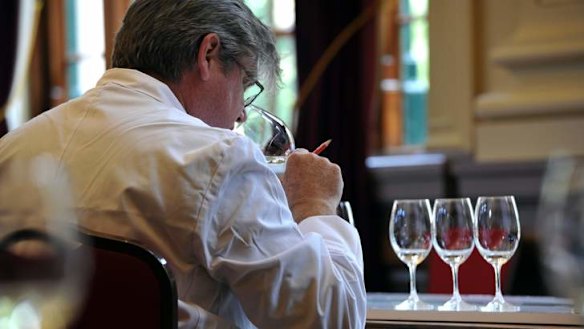Clare's riesling to fore
South Australia remains riesling heartland, but what went wrong in Canberra, asks <b>Chris Shanahan</b>.

Despite increasing entries in the Canberra International Riesling Challenge, the event remains largely Australian.
This year, 487 wines were entered from eight countries. Three-quarters of the wines, or 371, were from Australia. The second biggest exhibitor, the United States, fielded 35 wines, followed by New Zealand (34), Germany (26), France (17), and the Czech Republic (2), with one each from Canada and South Africa.
A sweet riesling from Germany's Rheingau district topped the awards; a Marlborough, New Zealand, wine beat all the other dry rieslings; and Ravensworth 2013 won the trophy as best Canberra district riesling.
As well as taking out the top award, Germany enjoyed the highest medal strike rate. Twenty-two (85 per cent) of its 26 entries won medals - 11 bronze, four silver and seven gold. New Zealand and France tied for second place, each with a 77 per cent medal strike rate.
Australia's 371 entries, from more than 35 regions, earned 230 medals. The strike rate of 62 per cent is impressive considering the large number of entries and their geographic diversity.
And the results highlight the continuing dominance of Australia's traditional riesling heartland - the Clare and Eden valleys. These two distinct regions lie on South Australia's Mount Lofty Ranges - Eden Valley in the high country on the Barossa Valley's east, with Clare a short distance to the north. A third region, High Eden, is a higher, cooler sub-region of the Eden Valley, registered separately in 2001.
Combined, Clare-Eden-High Eden exhibited 166 wines, or 45 per cent of the Australian total, and raked in 107 medals, 47 per cent of the Australian gongs.
Clare Valley alone entered 104 wines, the greatest number of any region or country, and won 13 gold, 13 silver and 42 bronze medals. But the medal strike rate of 65 per cent was significantly below last year's 73 per cent, underlining the stellar quality of the region's 2012 vintage.
As a pointer to the future, tiny Tasmania entered the greatest number of wines after the Clare and Eden valleys. The state's 39 rieslings won 17 bronze, three silver and five gold medals - a strike rate of 64 per cent. Like the Clare Valley, Tasmania's performance in 2013 fell short of its 2012 results - 34 medals from 42 entries, a remarkable strike rate of 81 per cent. Tasmania is on track to be Australia's capital for riesling as well as chardonnay and pinot noir.
Western Australia's vast Great Southern zone fielded 37 wines to win
26 medals (strike rate 70 per cent), comparable to last year. The high strike rate is consistent with the area's long-established reputation as one of Australia's leading riesling producers.
The serious underperformance of Canberra rieslings in the competition raises yet again the puzzling issue of inconsistency in wine show judging. A couple of weeks before the riesling challenge, judges at the Canberra and Region Wine Show awarded 21 medals, including six golds, to 26 wines in the 2013 vintage riesling class.
In the catalogue, the judges wrote, ''An extraordinary class of glorious rieslings - a true benchmark nationally and beyond. Purity, delicacy, beautiful fruit to the fore - a regional champion variety. Thank you.''
Fourteen of those 26 wines entered the riesling challenge. They won just six medals (one gold, one silver, four bronze) for a strike rate of 43 per cent. In the regional show, the same 14 wines won three gold, three silver and five bronze medals (strike rate 79 per cent).
Depending on which set of judges we believe, Canberra riesling is either pure, delicate and a national benchmark - or an also-ran. The discrepancy is hard to explain. Both sets of judges can't be right.
With that grain of salt then, we should troll the catalogue of results and always try before we buy.
Trophies
Best wine: Weingut Georg Muller Stiftung Schutzenhaus Trockenbeerenauslese 2011
Best New Zealand: Hunter's Marlborough 2012 (also best dry of show)
Best Australian: Pikes Traditionale 2013
Best American: Sheldrake Point Late Harvest 2013
Best Canberra district: Ravensworth 2013
Best Tasmanian: Frogmore Creek Botrytis 2011
Best Australian museum: D'Arenberg the Dry Dam 2008
Top golds in the riesling challenge
Pikes Vintners Traditionale 2013, Clare Valley, South Australia
Plantagenet 2013, Great Southern, Western Australia
Logan Wines Weemala Riesling 2013, Orange, NSW
Pinnacle Mockingbird Hill 2012, Clare Valley, South Australia
Frogmore Creek Botrytis Riesling 2011, Tasmania
Pauletts Aged Release Riesling 2008, Clare Valley, South Australia
Pewsey Vale the Contours Riesling 2008, Eden Valley, South Australia
Plantagenet Riesling 2005, Great Southern, Western Australia
D'Arenberg the Dry Dam Riesling 2008, McLaren Vale, South Australia
Brown Brothers Milawa Patricia Noble2008, King Valley, Victoria
La Cave des Vignerons de Pfaffenheim Riesling 2012, Alsace, France
Weinbaudomane Schloss Johannsberg 50 Degress Riesling Trocken 2012, Rheingau, Germany
Weingartner Stromberg-Zabergau Bonnigheimer Sonneneberg Riesling Kabinett 2012, Wurttemberg, Germany
Weingut Georg Muller Stiftung Hattenheimer Hassel Eiswein 2012, Rheingau, Germany
Weingut Georg Muller Stiftung Schutzenhaus Trockenbeerenauselese 2011, Rheingau, Germany
Kono Tohu 2013, Marlborough, New Zealand
Whitehaven Marlborough 2013, Marlborough, New Zealand
Hunter's Marlborough 2012, Marlborough, New Zealand
Forrest Botrytised 2012, Marlborough, New Zealand
Sheldrake Point Late Harvest 2013, Finger Lakes, United States
>> Chris Shananan is a wine judge, former liquor retailer and Canberra Times wine writer.